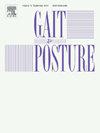Effects of divided attention on kinematic adaptations during obstacle-crossing in mild cognitive impairment
IF 2.2
3区 医学
Q3 NEUROSCIENCES
引用次数: 0
Abstract
Objective
Older adults with mild cognitive impairment (MCI) exhibit memory deficits and impaired postural control, increasing their fall risk, especially during obstacle negotiation. The study aimed to examine the end-point control and kinematic changes of the pelvis-leg apparatus in older adults with MCI during dual-task obstacle crossing, and to compare these changes across different tasks and obstacle heights.
Methods
Eighteen older adults with single-domain amnestic MCI walked and crossed at three obstacle heights under single-task and cognitive-motor dual-task conditions. Pelvis orientations and lower-limb joint angles and associated end-point parameters, such as leading and trailing toe-obstacle clearances and crossing speeds were measured. Two-way analyses of variance were used to study within-subjects (task and obstacle height) effects on the variables.
Results
Dual-task obstacle crossing led to significantly decreased crossing speeds and increased both leading and trailing toe-obstacle clearances (p < 0.05). Compared to single task, greater pelvic anterior tilt, upward list, hip flexion and abduction, and knee flexion in the swing limb, along with greater stance hip flexion were found during leading-limb crossing (p < 0.05). During trailing-limb crossing, greater pelvic posterior tilt and swing ankle dorsiflexion, but decreased pelvic upward list were found during dual task (p < 0.05).
Conclusions
Dual-task obstacle crossing induces significant kinematic adaptations in older adults with MCI, reflecting altered postural adjustments and end-point control. Monitoring these kinematic adaptations under dual-task obstacle crossing could serve as a valuable tool for assessing functional performance in MCI.
轻度认知障碍患者过障时分散注意力对运动适应的影响
患有轻度认知障碍(MCI)的老年人表现出记忆缺陷和姿势控制障碍,增加了他们跌倒的风险,尤其是在过障时。本研究旨在研究老年MCI患者在双任务越障过程中的终点控制和骨盆-腿部装置的运动学变化,并比较这些变化在不同任务和障碍物高度之间的差异。方法18例老年单域遗忘型轻度认知损伤患者在单任务和认知-运动双任务条件下行走和穿越3个障碍高度。测量骨盆方向和下肢关节角度以及相关的终点参数,如前后脚趾与障碍物的间隙和穿越速度。使用双向方差分析来研究受试者内(任务和障碍高度)对变量的影响。结果双任务过障显著降低了受试者的过障速度,提高了受试者的前、后趾离障距离(p <; 0.05)。与单一任务相比,摆动肢体的骨盆前倾、上倾、髋关节屈曲和外展、膝关节屈曲更大,以及前肢交叉时的站立髋屈曲更大(p <; 0.05)。下肢交叉时骨盆后倾和踝关节背屈增大,双任务时骨盆上倾减小(p <; 0.05)。结论双重任务过障诱导MCI老年人显著的运动学适应,反映了姿势调整和终点控制的改变。监测这些在双任务过障下的运动学适应可以作为评估MCI功能表现的有价值的工具。
本文章由计算机程序翻译,如有差异,请以英文原文为准。
求助全文
约1分钟内获得全文
求助全文
来源期刊

Gait & posture
医学-神经科学
CiteScore
4.70
自引率
12.50%
发文量
616
审稿时长
6 months
期刊介绍:
Gait & Posture is a vehicle for the publication of up-to-date basic and clinical research on all aspects of locomotion and balance.
The topics covered include: Techniques for the measurement of gait and posture, and the standardization of results presentation; Studies of normal and pathological gait; Treatment of gait and postural abnormalities; Biomechanical and theoretical approaches to gait and posture; Mathematical models of joint and muscle mechanics; Neurological and musculoskeletal function in gait and posture; The evolution of upright posture and bipedal locomotion; Adaptations of carrying loads, walking on uneven surfaces, climbing stairs etc; spinal biomechanics only if they are directly related to gait and/or posture and are of general interest to our readers; The effect of aging and development on gait and posture; Psychological and cultural aspects of gait; Patient education.
 求助内容:
求助内容: 应助结果提醒方式:
应助结果提醒方式:


